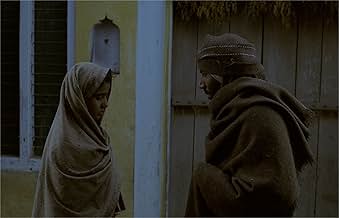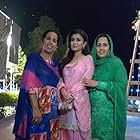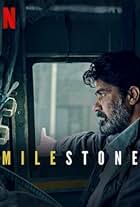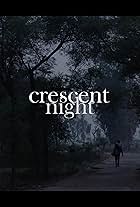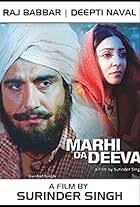IMDb RATING
7.1/10
322
YOUR RATING
A day in the life of a family in a village in Punjab as they deal with social and labor trials and inequities, leading to a night of a lunar eclipse.A day in the life of a family in a village in Punjab as they deal with social and labor trials and inequities, leading to a night of a lunar eclipse.A day in the life of a family in a village in Punjab as they deal with social and labor trials and inequities, leading to a night of a lunar eclipse.
- Awards
- 2 wins & 2 nominations
Dharminder Kaur Maan
- Mother
- (as Dharminder Kaur)
Storyline
Featured review
The film is set in a village in the outskirts of Bathinda city where villagers work in the fields of the local landlord. It is a village where people are trying hard to make peace with their existence.
On a foggy winter morning, a family wakes up to the news of the demolition of a house on the outskirts of the village. Father, a silent sympathizer, joins the community in demand for justice whilst his son Melu, a rickshaw puller in the city, participates in a strike by his union. Injured and alienated, Melu spends the day quietly resting and drinking with friends in the night they debate the meaning of their existence. Both father and son are equally clueless about their futures.
The film is a powerful exploration of the daily struggles of the urban and rural workers in a Punjab; where the gap between the rich and poor is getting wider and people's hopes and aspirations for a better life are shattered.
As the director says, it is difficult to say what the film is about as it can mean different things to different people, which it should. At the surface, the film speaks about the margins where the socially repressed and exploited have been conveniently cast away. It's about a day in the lives of a family who are witnesses to the play of power equation unfolding around them. It's about silent witnesses devoid of power to change or influence the course of destiny. It's about invisible violence and desires, simmering discontent and angst that are reflected on people's faces.
The village portrayed is not the picture-perfect Bollywood village with verdant mustard fields and huge private mansions. It showcases the underbelly of caste'ism and marginalized farmers. The helplessness and angst of Dalit's in a village in Punjab is beautifully captured.
Amazing part is that most of the actors in the movie are not real actors, but real villagers of the same village where the film is shot.
The creative producer of the movie, Mani Kaul, known for critically acclaimed movies like Uski Roti (1970) & Duvidha (1974) was also mentor of the director, which is clearly reflected in his style. Mani's parting words before the director left for the shoot were: "Go beyond what you know!" and the director says, "I would start feeling dissatisfied if things were going too much according to the plan. I kept struggling with Mani's thought. Having finished the film, now I know what he meant!" Gurvinder's style doesn't share much of functional details, although the way he handles the sounds, the empty frames & the silence, is incredible. This is what would probably alienate him from taking the film to a wider audience. He seems happier experimenting with the notions of time and space within a filmic narrative.
Anhey Ghorey Da Daan is nevertheless a rewarding watch for those who are open to not treading the beaten path!
On a foggy winter morning, a family wakes up to the news of the demolition of a house on the outskirts of the village. Father, a silent sympathizer, joins the community in demand for justice whilst his son Melu, a rickshaw puller in the city, participates in a strike by his union. Injured and alienated, Melu spends the day quietly resting and drinking with friends in the night they debate the meaning of their existence. Both father and son are equally clueless about their futures.
The film is a powerful exploration of the daily struggles of the urban and rural workers in a Punjab; where the gap between the rich and poor is getting wider and people's hopes and aspirations for a better life are shattered.
As the director says, it is difficult to say what the film is about as it can mean different things to different people, which it should. At the surface, the film speaks about the margins where the socially repressed and exploited have been conveniently cast away. It's about a day in the lives of a family who are witnesses to the play of power equation unfolding around them. It's about silent witnesses devoid of power to change or influence the course of destiny. It's about invisible violence and desires, simmering discontent and angst that are reflected on people's faces.
The village portrayed is not the picture-perfect Bollywood village with verdant mustard fields and huge private mansions. It showcases the underbelly of caste'ism and marginalized farmers. The helplessness and angst of Dalit's in a village in Punjab is beautifully captured.
Amazing part is that most of the actors in the movie are not real actors, but real villagers of the same village where the film is shot.
The creative producer of the movie, Mani Kaul, known for critically acclaimed movies like Uski Roti (1970) & Duvidha (1974) was also mentor of the director, which is clearly reflected in his style. Mani's parting words before the director left for the shoot were: "Go beyond what you know!" and the director says, "I would start feeling dissatisfied if things were going too much according to the plan. I kept struggling with Mani's thought. Having finished the film, now I know what he meant!" Gurvinder's style doesn't share much of functional details, although the way he handles the sounds, the empty frames & the silence, is incredible. This is what would probably alienate him from taking the film to a wider audience. He seems happier experimenting with the notions of time and space within a filmic narrative.
Anhey Ghorey Da Daan is nevertheless a rewarding watch for those who are open to not treading the beaten path!
- Deepak_Futela
- Jan 22, 2013
- Permalink
Details
- Release date
- Country of origin
- Language
- Also known as
- Jałmużna dla ślepego konia
- Production company
- See more company credits at IMDbPro
- Runtime1 hour 52 minutes
- Color
- Aspect ratio
- 1.85 : 1
Contribute to this page
Suggest an edit or add missing content

Top Gap
By what name was Alms for a Blind Horse (2011) officially released in Canada in English?
Answer

